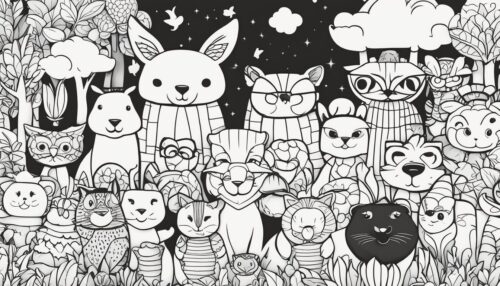Pictures to Color for Kindergarten: Fun and Educational Designs. Coloring pages for kindergarten are a fantastic way to kickstart young learners’ creativity while also building essential skills. These pages offer opportunities for kids to engage with different colors and shapes, fostering both their imagination and fine motor skills. Parents and educators alike can see the positive impact on children’s early learning and artistic development.
Pictures to Color for Kindergarten




Kindergarten coloring pages often blend fun with educational themes, making them ideal for both classroom settings and home activities. Whether it’s a friendly-looking butterfly flying above a field of flowers or simple color-by-number and color-by-letter worksheets, these activities help children learn to follow instructions and recognize patterns. The variety ensures that kids remain interested and motivated.
Pictures to color for kindergarten not only entertain but also enhance cognitive abilities. By coloring images of familiar objects, such as kitchen items or basic math shapes, children start associating colors with their world. This creates a foundation for future learning and self-expression in a comfortable and enjoyable format.
The Importance of Coloring in Early Education



Coloring plays a significant role in early childhood education by fostering creativity, enhancing motor skills, and developing hand-eye coordination. Using colorful pictures and engaging activities, children also learn color recognition and build vocabulary.
Encouraging Creativity and Imagination
Coloring allows children to express themselves in unique ways. As they choose colors and apply them to pictures, they explore various hues and create combinations that reflect their thoughts and feelings. This artistic expression is a vital form of self-expression, as it permits children to translate their inner world onto paper.
Through this process, children engage in imaginative play, envisioning stories and scenarios for the subjects they color. This development of creativity and imagination is crucial, as it lays the foundation for innovative thinking and problem-solving skills later in life.
Developing Fine Motor Skills
Coloring activities are excellent for building fine motor skills. Holding and maneuvering crayons or colored pencils helps strengthen the small muscles in the hands, fingers, and wrists.
This strength is essential for other tasks like writing, cutting, and even using a keyboard. By improving these fine motor skills, children gain better control and precision over their movements, which contributes to their overall physical development.
Moreover, the repetitive motion of coloring within defined spaces enhances their dexterity and prepares them for more complex tasks that require a steady hand and detailed movements.
Enhancing Hand-Eye Coordination
Hand-eye coordination is another critical skill developed through coloring. As children focus on coloring within the lines of a picture, they must synchronize their hand movements with their visual perception. This activity helps them improve their hand-eye coordination, which is necessary for many daily tasks such as texting, catching a ball, or tying shoelaces.
Improved hand-eye coordination also supports academic activities. For instance, children with refined coordination can better manage tasks like writing, which requires the integration of visual cues with hand movements.
Color Recognition and Vocabulary Building
Coloring activities are integral in teaching children about colors. Recognizing and naming different colors enhances their color recognition skills. Educators and parents can use coloring books to introduce terms such as “light blue,” “dark green,” and “magenta,” expanding the child’s descriptive vocabulary.
By associating colors with specific objects and scenarios, children not only learn to identify various colors but also understand how colors can evoke emotions and convey meanings. This enrichment of their vocabulary aids in clearer communication and better educational benefits.
Through these combined efforts, coloring becomes a multifaceted educational tool that supports numerous aspects of a child’s growth and development.
Selecting Appropriate Coloring Materials



Selecting the right coloring materials for kindergarten students is fundamental for fostering creativity and ensuring safety. It is important to choose tools that are safe, easy to use, and consider both store-bought and non-commercial options.
Choosing Safe and Easy-to-Use Coloring Tools
When selecting coloring tools, safety is the top priority. Crayons and colored pencils are highly recommended due to their non-toxic nature and ease of use for small hands. Some brands label their products as ASTM D-4236 compliant, which indicates they meet safety standards.
Crayons: Soft and non-toxic, they are perfect for young children. Crayons with a larger diameter provide better grip for little fingers, improving control and minimizing frustration.
Colored Pencils: These are harder and can create fine lines. Opt for those with a thicker core and ergonomic design, like triangular shapes, to enhance grip.
Markers: Make sure to choose washable markers to avoid stains on clothes and skin. Many come with a ventilated cap as an additional safety feature.
Pencil Grips: Adding pencil grips can help children hold crayons and pencils more comfortably, promoting better handwriting skills.
The Benefits of Non-Commercial Coloring Pages
Non-commercial coloring pages offer numerous advantages, especially for educational settings. These resources are often free and widely accessible, making them ideal for classroom use or at-home activities.
Educational Value: Non-commercial pages usually integrate educational themes, like alphabet letters, numbers, and simple math problems, which reinforce classroom learning.
Versatility: They can be easily customized to fit specific educational goals or themes, providing tailored learning experiences.
Creativity and Engagement: These pages encourage self-expression and creativity without the influence of commercial characters, which can sometimes limit imaginative play.
Cost-Effective: Since many non-commercial coloring pages are available online for free, they provide a budget-friendly option for teachers and parents.
By carefully selecting both safe and effective coloring tools and utilizing non-commercial coloring pages, educators and parents can create a productive and enjoyable environment for kindergarten students.
Themes and Subjects for Kindergarten Coloring Pages


When selecting coloring pages for kindergarten, educators and parents often look for themes that engage children while reinforcing learning. These pages can be tailored to various educational concepts, seasonal festivities, nature, and imaginative worlds.
Incorporating Educational Themes
Educational coloring pages play a crucial role in facilitating learning. Pages featuring alphabet letters, numbers, and simple math concepts help children get familiar with these basics. Science themes, such as the life cycle of a butterfly or parts of a tree, are also popular. Incorporating educational themes ensures children are engaged, and they learn in the process.
Examples:
- Alphabet A for Apple
- Counting with ice cream cones
- Parts of a fish labeled
Seasonal and Holiday Motifs
Seasonal and holiday motifs make coloring a year-round activity. Spring coloring pages might include blooming flowers, butterflies, and trees. Winter pages could feature snowmen and festive decorations. Other holidays like Halloween and Christmas introduce themes like spooky creatures and Santa Claus, making learning festive and fun.
Examples:
- Spring scenes with blooming flowers
- Easter eggs and bunnies
- Christmas trees and snowmen
Animals and Nature
Animals and nature are universally exciting topics for young children. Coloring pages of wild and domestic animals, such as lions and dogs, captivate children while helping them learn about different species. Fish in an ocean scene or a tree with different fruits offer a natural way to explore the world around them.
Examples:
- Forest animals: deer, bears
- Sea life: fish, turtles
- Insects: butterflies, ladybugs
Fairy Tales and Fantasy
Fairy tales and fantasy themes stimulate children’s imaginations. Coloring pages featuring fairies, elves, and mythical creatures allow children to escape to inventive worlds. Stories like Cinderella or Jack and the Beanstalk can be revisited in coloring form, giving children a visual and creative connection to these tales.
Examples:
- Fairy princesses in enchanted forests
- Dragons and knights in medieval scenes
- Unicorns and magical lands
By selecting appropriate themes and subjects, kindergarten coloring pages become powerful tools for both education and entertainment. Children can explore the world, learn new concepts, and enjoy holidays and fantasies all through the simple joy of coloring.
Learning Through Coloring Activities
Coloring activities provide an engaging way for kindergarten children to develop foundational skills, including number recognition, letter association, and fine motor skills. These activities also offer a playful avenue to reinforce concepts in other subject areas like math and science.
Worksheets to Support the Kindergarten Curriculum
Coloring worksheets can be effective educational tools. They help children learn alphabet letters, numbers, and shapes while engaging their creativity. For instance, worksheets that incorporate letter tracing and simple drawings can support early writing skills.
In addition, simple coloring pages featuring alphabet characters or number sequences can help cement knowledge through repetition. Worksheets themed around familiar objects or scenes can make learning more relatable and enjoyable for young learners.
Color-by-Number and Connect-the-Dots
Color-by-number and connect-the-dots activities combine fun with learning. These worksheets require children to follow instructions and recognize numbers or letters, improving their cognitive abilities.
For example, a color-by-number worksheet might help children identify and match colors to numbers. A connect-the-dots sheet can encourage them to practice counting and enhance their fine motor skills as they draw lines to complete a picture.
Integrating Coloring with Other Subject Areas
Coloring can be a valuable tool for teaching other subjects. In science, coloring pages featuring plants, animals, or weather phenomena can make learning more engaging. These visuals can help children better understand and remember scientific concepts.
Math-focused coloring pages can involve exercises like making ten or simple addition problems. Writing can also be integrated by having kids color and label parts of a story or sentence. By using coloring as a dynamic educational resource, an inclusive approach to learning is achieved, fostering various skills in a fun and interactive manner.
Tips for Parents and Educators
Providing quality coloring activities can engage young learners and support their development in fun, creative ways.
Facilitating Engaging Coloring Sessions
Creating a captivating coloring experience is vital. Start by setting up a comfortable area with plenty of natural light. Ensure that materials such as crayons, markers, and colored pencils are easily accessible.
Encourage children to explore and express their creativity. Offer themes that align with their interests, such as animals, vehicles, or fairy tales. Additionally, discussing their color choices and artwork can boost confidence and communication skills.
Interactive coloring involves more than just filling spaces with color. Consider incorporating games like color-by-number sheets or color-by-letter activities. These not only make the sessions fun but also reinforce learning concepts such as numbers and letters.
Incorporating Coloring into Daily Routines
Integrating coloring into daily routines can be both fun and convenient. Designate specific times during the day, such as after breakfast or before bedtime, to sit and color. This consistency creates a habit and something children can look forward to regularly.
Parents and educators can use coloring as a transition activity between tasks. For instance, a quick five-minute coloring session can help children settle in after outdoor play or calm down before starting a new lesson.
Including coloring in social playdates or group activities can also foster cooperative play. Encourage children to share coloring materials and work on collective art projects, promoting teamwork and social skills.
Resources for Free and Printable Coloring Pages
Parents and educators have an abundance of resources for free and printable coloring pages. Websites like Mom Loves Best offer themed collections specifically designed for young learners, blending fun with educational themes.
Alternatively, platforms such as Easy Drawing Guides provide a variety of printable coloring sheets that cover a wide range of subjects. Using these resources can keep children engaged and continuously excited about coloring.
Educators can bookmark pages with vast libraries of coloring sheets, ensuring they always have fresh and relevant material. Furthermore, leveraging printable pages allows for versatile use both in classrooms and at home, making coloring a readily accessible activity.
Developmental Benefits of Coloring
Coloring can have notable effects on creativity. By experimenting with different colors, styles, and techniques, children exercise their imagination. This process helps them discover unique ways to express themselves.
Self-expression is another key benefit. Coloring pages give young children the opportunity to make choices about their artwork. This fosters decision-making skills and personal preferences.
Fine motor skills, such as hand strength and coordination, improve with regular coloring activities. These skills are foundational for handwriting skills as children learn to control writing tools precisely.
Coloring also promotes educational benefits. For instance, it helps kids learn color recognition, shapes, and patterns. These are essential concepts for young learners, especially kindergarteners and preschoolers.
Kids of all ages can benefit from the calming effect of coloring. This can support stress relief and focus, making it a valuable activity for children in various developmental stages.



